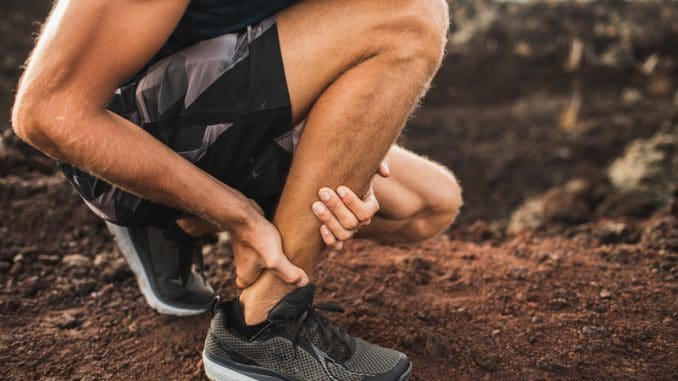
The Achilles tendon is a large band of fibrous tissue that connects the muscles of the calf to the heel bone. The Achilles tendon is also called the calcaneal tendon. When the calf muscles contract, they pull on the Achilles tendon, which allows you to stand up on your toes, as needed for walking, running, or jumping. The Achilles tendon is the largest and strongest tendon in the body and takes on a huge amount of force, thus making it very susceptible to injury. Injuring the Achilles tendon can result in pain and inflammation in the back of the heel. This can prevent you from walking, running, or moving through a full range of motion.
If you notice pain on the back of your heel, it could be an Achilles injury. It is always a good idea to go to a doctor, physiotherapist, or chiropractor to get your injury assessed and to determine the right rehabilitation strategy for you. In this article, we will go through four simple exercises and stretches that can help heal your Achilles tendon injury.
There are several injuries that are common to the Achilles tendon:
- Achilles Tendon Tear: Tears can be small (microtears) or large. This can result in pain, swelling, and inflammation in the back of the heel or leg.
- Achilles Tendon Rupture: This is when the entire tendon actually separates. Usually, this results in a popping sound, then pain and inflammation. Often this type of injury requires surgery.
- Achilles Tendinitis: This results from prolonged activities such as walking or running that gradually inflame the tendon, resulting in pain and tightness.
Below we have shared some exercises and stretches that can help provide relief from Achilles tendon injuries. Always check with a healthcare professional before doing these exercises to make sure they are safe for your specific injury.
Calf Raise with a Single Leg Lower
 |
 |
This exercise helps gently strengthen the calf muscle and Achilles tendon through eccentric contractions. By lowering down on one leg, you strengthen the muscles without having to lift your entire body weight upon one leg. This makes the exercise effective and also safer for rehabilitation. Begin by standing with your feet hip-distance apart. Hold onto the back of a stable chair or wall for balance if needed. Using both feet, raise to your toes. Lift your healthy leg off the floor so you are standing on your affected leg. Using only your injured leg, slowly lower your heel back to the ground. Place both feet on the floor and repeat the movement.
Perform 3 sets of 10 repetitions.
Modifications: To make this exercise easier, lower down using both feet, taking some of the weight off of the injured leg. To make this exercise more challenging, stand on a step with your heels hanging off the edge. Rise up on both feet, then lower down on your injured leg. This will move your ankle through a larger range of motion and requires more strength from your injured leg.
Single-Leg Standing Balance
This exercise improves your balance and requires your stabilization muscles to fire in order to keep you balanced. Sometimes Achilles injuries can result from muscle imbalances such as weak glutes. Practicing balancing can help strengthen and engage important muscles to improve your posture and movement patterns. Begin by standing on both feet, using the back of a chair or wall for stabilization if you need it. Ground down into the foot of the affected leg. Make sure to lift the inner arch of your foot to avoid a flat foot (this will result in pulling your Achilles tendon at an angle). Do this by pressing into the outer edge of your foot. Lift your other leg off the ground and balance on your injured leg. You may find it helpful to look at a spot on the floor or wall to help you balance.
Perform 1 set of 3 repetitions. Work your way up to a 30-second hold.
Modifications: To make this exercise easier, use support for balance, and hold only for 5 or 10 seconds. To make this exercise more challenging, balance on your own, and hold for as long as possible.
Calf Stretch
When your calf muscles are tight, they can pull on the Achilles tendon. Over time, this can cause further pain and injury as the tendon becomes strained and aggravated. Begin by standing in front of a wall. Place both hands on the wall in front of you and step back with your affected leg. Straighten your back leg and work your heel toward the floor. Bend your front knee as much as you need to. You are looking for a stretch through the back of your calf, maybe into the back of your heel as well. The intensity of the stretch should be light.
Perform 1 set of 3 repetitions. Hold for 20 seconds.
Achilles Stretch
This stretch is a variation of the previous one, targeting lower down in the calf and into the Achilles tendon. This will help loosen up the injured area to promote a better range of motion. Begin by standing in front of a wall. Place both hands on the wall in front of you and step back with your affected leg. This time, bend your back knee while working your heel toward the ground. You should feel this more toward the heel and in the lower calf muscle. The intensity of the stretch should be light.
Perform 1 set of 3 repetitions. Hold for 20 seconds.
These movements will help to strengthen the muscles around the Achilles tendon and stretch out the area to improve mobility and promote healing. I hope these stretches are helpful and bring you some relief from your Achilles tendon injury.
Suffering from Achilles tendinitis? You are not alone! For your comprehensive guide to healing Achilles tendonitis, check out the Achilles Tendonitis Exercise Solution here!




